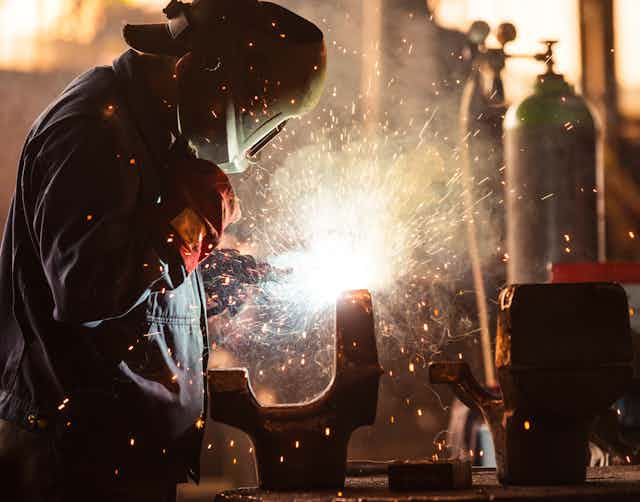Alexander Hamilton, one of the founding fathers of the US, wrote a wealth of reports that served as building blocks for the country’s economic system. In 1791, during his time as secretary of the Treasury, Hamilton published one of his most important: the Report on the Subject of Manufactures.
It argued that the US needed to develop its manufacturing sector through the use of industrial and trade policy to grow its economy, bolster its military, increase its productivity, and catch up with the industrial and technological powerhouse of the time, Great Britain.
Hamilton died in 1804. But US policymakers, led by Henry Clay, followed Hamilton’s advice. Throughout the 19th century, the US succeeded in its mission of catching up with Great Britain and eventually became the world’s technological superpower.
It’s important that we remember Hamilton’s report. It’s a reminder of how thinking and strategising for economic growth and international competitiveness was changing. It was changing to a mindset that national sovereignty, economic development, international competitiveness and productivity growth are achieved through industrialisation.
But this long-established relationship between economic prosperity and industrialisation is now starting to change. So-called “megatrends” (technological, economic, societal and ecological trends that have a global impact) are changing traditional ideas of technological progress and, as a result, the way countries look to develop their economies.
My book The Future of the Factory investigates how four megatrends are changing (and not changing) industrialisation and manufacturing-led growth. These megatrends are: the rise of services, digital automation technology, globalisation of production and ecological breakdown.
Digital technology
In some ways, megatrends are not changing or diminishing the importance of manufacturing-led development.
Digital services are increasingly seen as an alternative to manufacturing in boosting economic development. But they are not replacing the manufacturing sector as the engine of innovation and productivity growth. The manufacturing sector still scores substantially higher than the service sector on tradeability, innovation potential and spillovers to other parts of the economy.
Digital automation technology has also undoubtedly been disruptive in some sectors and countries. But they are not a significant threat to overall job displacement. This is primarily because automation technology tends to create more jobs than it displaces.
The introduction of the personal computer (PC) is a great example. In the US, the PC created 15.8 million more jobs than it displaced between 1980 and 2015. Research has also found that the countries who faced a higher overall automation risk in the early 2010s experienced higher employment growth than other countries in subsequent years.
It seems we are excessively hyping up the expected impact of new technology on economic organisation, as we have done so many times in the past. Industrialisation and factory-based production remain crucial for economic development and innovation.

Uneven opportunities
Power asymmetries in the world economy are, however, creating uneven opportunities to reap the benefits from industrialisation. At worst, they are making it harder for developing countries to industrialise altogether.
Transnational corporations based in high-income countries are more powerful than ever. And they often use this power to prevent countries, firms and workers in developing countries from getting a fair share of profits in global production systems.
Apple, for example, doesn’t actually “make” the iPhone. It outsources the production of every single component. But Apple still somehow manages to walk away with over 50% of the final retail price.
By contrast, the firms and workers in developing countries who assemble the iPhone (the most labour intensive part of the process) get less than 1.5% of the final price. Large corporations like Apple also use their power to lobby for international trade agreements to work in their interests.
Additionally, high-income countries refuse to take their fair share of blame for ecological breakdown. They preach green industrial policy to developing countries before putting their own house in order.
A recent study found that high-income countries were responsible for 74% of global excess resource use between 1970 and 2017, despite accounting for only 15% of the world’s population. By contrast, low-income and lower-middle income countries, which make up around 50% of the world’s population, accounted for a mere 1% of global excess resource use over this period.
Given these developments, our system of international trade needs to be reformed so that it is fair rather than “free”. And developing countries should also have more ecological policy space in their implementation of industrial policy. The burden to deal with ecological breakdown should fall mainly on high-income countries, as these are the countries that got us into this mess.
The return of industrial policy
In many ways, Alexander Hamilton’s insights are still timely. Hamilton stressed the urgent need for policymakers to build up manufacturing capabilities to achieve economic growth and development.
This is what the US government is currently doing in an effort to re-industrialise its economy and especially to become more competitive with China. In July 2022, the US Senate passed a historic US$280 billion (£222 billion) industrial policy bill — the largest industrial policy bill in history.
And the US is not the only country actively revamping industrial policy. The global use of industrial policy is at an all-time high as the world grapples with geopolitical tension and shocks to global supply chains. Although megatrends are changing industrialisation in some ways, they are not changing its importance.

We can also use Hamilton’s insights to understand the nature of competition in the modern world economy. The world economy is vastly different today, but we need to understand, like Hamilton understood, that industrialisation is a competitive game that involves power, politics, dirty play – and even warfare.
If the playing field is level, competition isn’t all that bad. But the global playing field today certainly isn’t level when it comes to the distribution of industrial and technological capabilities. This is one of the main obstacles to economic development in the 21st century.

